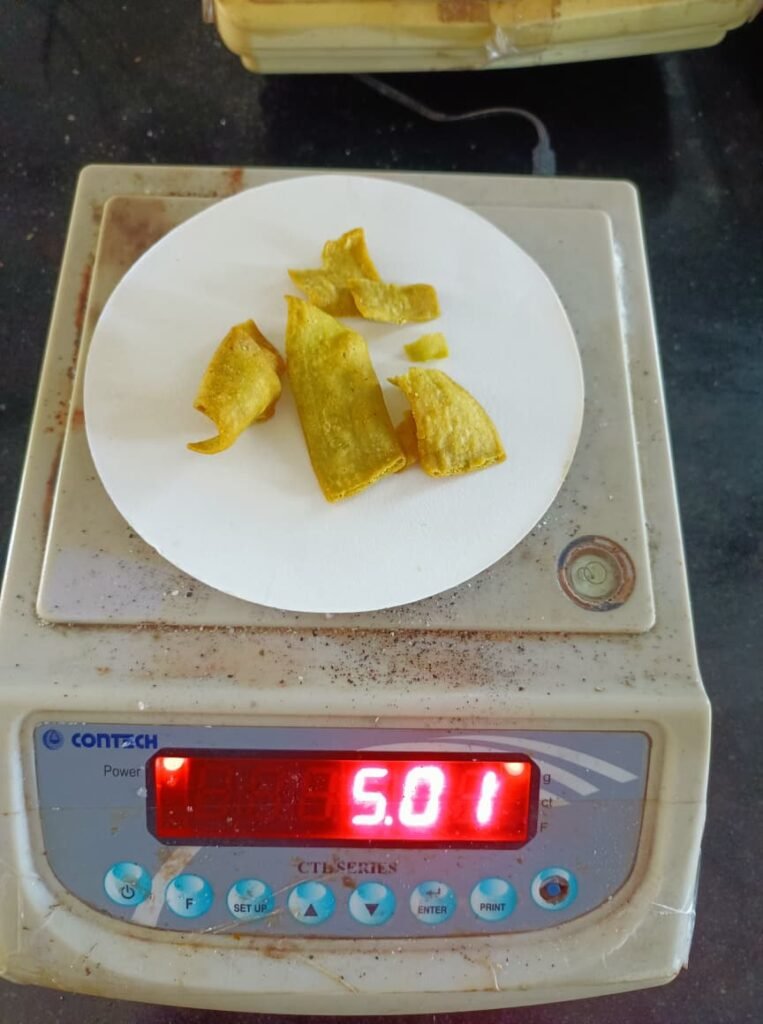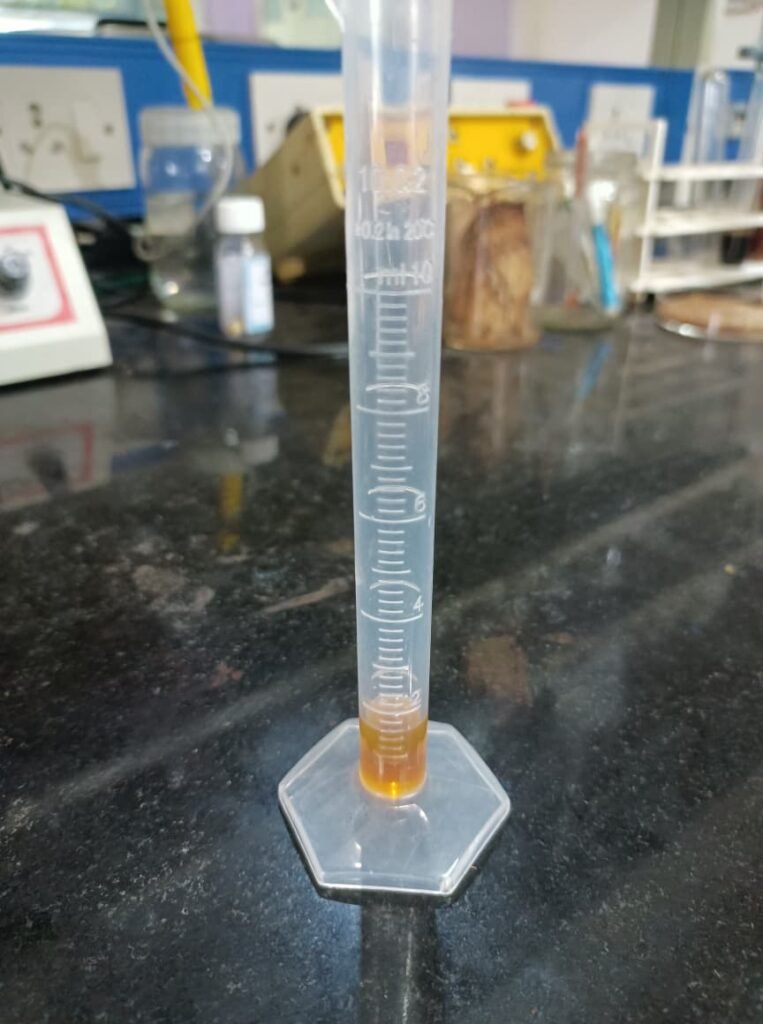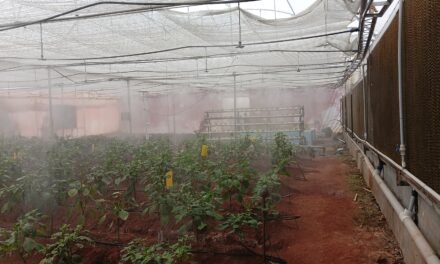Introduction
Our project is about making a healthy and crunchy snack using a mix of millets, different flours, and moringa powder. These snack is being made for Agro rangers Pvt. Ltd. The goal is to create a tasty snack that gives people better nutrition and more variety.
Moringa has different benefits as follows:
- Rich in Nutrients: Moringa is packed with vitamins (like vitamin C, A, and E), minerals (such as calcium and iron), and all essential amino acids, making it a true powerhouse for nutrition.
- Antioxidant Properties: It contains powerful antioxidants, which help protect the body against damage from free radicals and keep cells healthy.
- Supports Heart Health: Moringa may help lower cholesterol and manage blood pressure.
- Helps Manage Blood Sugar: Some studies suggest moringa can help lower blood sugar levels, supporting better management of diabetes.
- Anti-Inflammatory: It has natural anti-inflammatory effects that may help reduce swelling and protect the body from chronic diseases.
- Boosts Immunity: The high nutrient content and bioactive compounds make it a great support for a strong immune system.
- Supports Digestion and Liver Health: Moringa may aid digestion and help protect the liver.
- Natural Energy Booster: Thanks to its nutrition profile, moringa is a great, natural way to increase energy and fight tiredness.
Reference :- https://www.ncbi.nlm.nih.gov/pmc/articles/PMC9916933/
Objectives
- Create a mix of millets, other flours, and moringa to make a snack that is both healthy and delicious.
- Find the best way to make, fry, and pack these snacks so they stay fresh and can be enjoyed for a longer time.
Starting with sample
We have now started the work, using a sample given by Agrorangers coordinator, Subodh Sir. Our aim is to make the product just like that sample or try to make it even better in taste and quality.
After discussing with Dixit sir, I’ll perform a Soxhlet extraction to find out the oil content in the sample. This will help to check how much oil is present and whether the sample is actually fried or not.
Work on Oil Extraction
Soxhlet Oil Extraction Process
- Sample amount: 5 grams
- Solvent: Approximately 350 ml hexane

Step 1: Preparing the setup
- Placed the solid sample inside a filter paper.
- Inserted the sample into the Soxhlet extractor body.
- Connected the extractor to a round-bottom flask containing hexane.
- Attached the condenser unit on top of the Soxhlet extractor.
Step 2: Extraction process
- Heated the round-bottom flask to boil hexane.
- Hexane vapor rose, traveled up to the condenser where it cooled and condensed.
- The condensed hexane dripped back into the extractor, washing over the sample repeatedly.
- The extracted oil dissolved in hexane and siphoned back into the flask.
Step 3: Separating oil from hexane
- After extraction, disassembled the setup by removing the condenser and extractor parts, leaving the flask with the hexane-oil mixture.
- Removed hexane by evaporation to isolate the oil.
Step 4: Results
- Extracted approximately 1.48 grams (about 1.8 ml) of oil from 5 grams of sample.

To calculate the oil content percentage :-


So, the oil content of sample is 29.6% ; ≈ 30%
Discussion With Dixit sir
Step 1: Choosing the Right Composition
Discussion with Dixit Sir, we agreed that the most important part of making Moringa Bites is deciding which flours to use. We want to focus on simple, traditional Indian ingredients like traditional flours & legumes and local millets. These are packed with protein, iron, zinc, and other important minerals that our bodies need. They also provide all the essential amino acids, which are the building blocks of good nutrition.
By using these natural and familiar ingredients, we can make Moringa Bites that are:
- High in protein
- Rich in minerals like iron and zinc to support health
- Balanced with all the important amino acids our body needs
- Made from traditional ingredients that people trust
This way, we create a healthy snack that’s both nutritious and connected to our food culture.
Here is the study of millets focusing on their nutritional parameters based on our set criteria for Moringa Bites:
| Millet | Protein (%) | Iron (mg/100g) | Zinc (mg/100g) | Calcium (mg/100g) | Fiber (%) | Glycemic Index | Notes |
|---|---|---|---|---|---|---|---|
| Bajra (Pearl Millet) | 11–14 | 7.5 | 3.0–4.0 | 40–50 | 7–8 | Low (~50) | Nutty flavor, mineral-rich |
| Jowar (Sorghum) | 9–12 | 4.3 | 2.1 | 30–40 | 6–8 | Medium (~62) | Moderate protein and minerals |
| Ragi (Finger Millet) | 7–9 | 3.9 | 2.2 | 344 | 3–4 | Low (~55) | Very high calcium |
| Oat Flour | 13 | 4.2 | 3.1 | 40–52 | 10.6 | Low (44) | Adds fiber and moisture |
| Foxtail Millet | 11–13 | 2.6–4.5 | 1.0–2.5 | 14–35 | 6–8 | Low (31–52) | Low GI, mild flavor |
| Barnyard Millet | 11–12 | 7.6 | 2.1 | 11–13 | 7–9 | Low (~52) | High iron, good fiber |
| Amaranth | 13–15 | 7.6 | 2.9 | 159 | 6.7 | Low (~35) | Nutty flavor, high minerals |
After studying many different millets, we found that Bajra (Pearl Millet) is the best flour to use for our Moringa Bites. Here’s why:
- Better overall balance: Bajra has a good mix of protein, minerals (iron and zinc), fiber, and low glycemic index all together.
- Taste and texture: Bajra’s mild, nutty flavor and good binding ability work well in fried snacks, giving the right crispness and taste.
- Availability: Bajra is widely grown and available locally, making it a sustainable and cost-effective choice.
- Consumer preference: Bajra-based snacks are well accepted traditionally and enjoyed by many.
- Nutritional impact: Bajra’s higher iron and zinc content compared to some other millets helps us create a more nutrient-rich product.
While Bajra is our main flour providing minerals, fiber, and flavor, we also needed a secondary flour to boost the protein content and improve taste and texture. After studying several options, we selected Moong Dal flour for these reasons:
- High Protein: Moong Dal has about 22–24% protein, one of the highest among pulses, making it perfect to increase the protein density of the snack.
- Complete Amino Acids: Moong Dal offers an excellent amino acid profile, rich in lysine, complementing millet proteins which are usually low in this essential amino acid.
- Mild Flavor: It has a pleasant, mild taste that blends well and does not overpower the nutty flavor of Bajra or the moringa powder.
- Soft Texture: Moong Dal adds softness and lightness to the snacks, balancing the dense texture of millet flour and resulting in good crunchiness after frying.
- Digestibility: It is gentle on the stomach and widely accepted in traditional diets, improving the overall palatability of the bites.
How We Use Moong Dal to Boost Protein and Nutrition !!
- After sprouting, moong dal grains are dried and ground into fine flour.
- This sprouted flour is mixed with Bajra flour and moringa powder in the formulation.
- Using sprouted flour results in Moringa Bites with higher protein, better mineral absorption, and improved texture and flavor.
- Also, I searched for one composition with the desi ingridient, and i came up with the Kulith (Horse gram) flour
Why Use Kulith in Moringa Bites?
Kulith is very nutritious and offers several benefits that make it an excellent choice for our Moringa Bites:
- High in Protein: Kulith has around 20–25% protein, helping make the snack filling and good for muscle health.
- Rich in Minerals: It is rich in important minerals like iron and zinc, which support immunity and energy.
- High Fiber: Kulith contains a lot of dietary fiber, which supports digestion and helps control blood sugar.
- Low Glycemic Index: It releases energy slowly, making it friendly for people managing blood sugar.
- Good Flavor and Texture: Kulith adds an earthy, nutty taste and provides a nice texture in the snack.
- Traditional Ingredient: Kulith is a traditional Indian pulse with a history of use in health-supportive foods.
So, I came up with another composition with this :-
| Ingredient | Percentage (%) |
|---|---|
| Kulith (Horse Gram) flour | 36 |
| Moong dal flour | 36 |
| Moringa leaf powder | 6 |
| Oil (frying absorption) | 30 |
| Spices (cumin, coriander, ginger, chili, turmeric) | 4 |
Now, afterwards We’ll take trials on both compositions
As per this composition i took one trial of it
Trial : 1 using Kulith

Observation
- Product turns hard and dense because kulith and moong have low starch and high protein, so no puffing during frying.
- High oil absorption occurs as the dense structure traps oil on the surface but stays tough inside.
- Texture becomes powdery and breaks easily due to poor binding and coarse fiber in kulith.
Trial : 2 using Jowar
Composition
| Ingredient | Quantity (g) |
|---|---|
| Jowar flour | 36 g |
| Moong powder | 30 g |
| Moringa leaf powder | 5 g |
| Peri Peri masala | 5 g |
| Salt | 2 g |
| Oil (moyan, mixed before dough) | 2 g |
| Oil absorbed during frying | ~30 g |
Process
- All dry ingredients (jowar, moong, moringa, peri peri, salt) were mixed thoroughly.
- About 2 g warm oil was added and rubbed into the mix (moyan) for light binding.
- Warm water was then added gradually to form a semi-stiff dough.
- The dough was shaped into bite-size pieces and deep-fried at approximately 170°C until crisp.


Observations
- Taste: Pleasant and flavorful due to peri peri; moringa taste was mild and balanced.
- Texture: Bites were crispy and light, but appeared slightly over-fried (darker color).
- Issue: The product became a bit too fried and oily on the surface — likely because there was no proper binding agent in the mix.
Post-Trial Discussion
After discussion with Dixit Sir, it was concluded that a binder is essential in the Jowar–Moong formulation to improve structure, frying stability, and oil absorption control.
However, instead of using a regular binder like rice flour or starch, the team decided to use a protein-rich natural binder to maintain the nutritional value of the product.
Choosing the Right Binder: Sprouted Harbhara Dal vs. Regular Besan
The first critical decision was choosing a protein-rich binder. Traditionally, besan (chickpea flour) is used in many snack preparations. However, we observed that besan, though rich in protein, has some limitations:
| Ingredient | Protein (%) | Carbohydrate (%) | Digestibility | Notes |
|---|---|---|---|---|
| Regular Besan | 22–24 | 55–60 | Medium | Standard flour, slightly dense texture |
| Sprouted Harbhara Dal | 28–30 | 45–50 | High | Sprouting improves digestibility, reduces anti-nutrients, gives better protein availability, and a lighter texture |
Selected Binder: Sprouted & Dried Harbhara Dal Powder
Reason for Selection
Using it in sprouted and dried form will significantly improve digestibility, texture, and flavor.
Observation: Sprouting the Harbhara dal significantly improved protein availability, digestibility, and binding properties, making it ideal for Moringa Bites.
Harbhara (chickpea) is rich in protein, iron, and natural starch, making it both a binder and a nutrient enhancer.
It also blends well with jowar and moong, complementing their amino acid profiles.
Final Ingredient Composition
After experimentation and discussions, we decided on a blend of sprouted Harbhara dal flour, Jowar flour, and Moong flour, combined with Moringa leaf powder and spices for flavor and nutrition. This combination offered the right balance of protein, carbohydrates, and micronutrients, while keeping the snack crisp and tasty.
Composition per 100 g batch
| Ingredient | % | Function / Benefit |
|---|---|---|
| Sprouted Harbhara dal flour | 35% | Protein-rich binder; enhances texture and nutrition |
| Jowar flour | 20% | Provides crispness and a light, crunchy texture |
| Moong flour | 10% | Adds digestible protein and mild flavor |
| Moringa leaf powder | 5% | Source of iron, calcium, antioxidants, and green color |
| Peri Peri masala | 4% | Adds spicy-tangy flavor |
| Salt | 1% | Balances taste |
| Oil (mixed in dough) | 2% | Helps binding and soft texture |
| Oil (absorbed during frying) | 30% | Gives crispness and mouthfeel |
I took a trial as per this composition :
| Ingredient | Weight (g) | Function / Benefit |
|---|---|---|
| Jowar flour | 171 g | Base starch for crispness and light texture |
| Sprouted Harbhara dal flour | 300 g | Protein-rich binder; improves structure, color, and nutrition |
| Moong flour | 86 g | Adds digestible protein and mild flavor |
| Moringa leaf powder | 43 g | Source of iron, calcium, antioxidants, and green color |
| Peri Peri masala | 34 g | Adds spicy-tangy flavor and aroma |
| Salt | 9 g | Balances taste |
| Oil (mixed in dough) | 17 g | Helps in binding and reduces hardness |
| Oil (absorbed during frying) | 257 g | Gives crispness, texture, and mouthfeel |
Step 1: Mixing
- All the dry powders – sprouted Harbhara dal flour, Jowar flour, Moong flour, moringa powder, peri peri masala, and salt – were combined in a large bowl.
- The mixture was stirred well until uniformly blended.
- 17 g of oil was added to the mix and kneaded lightly to form a slightly firm dough. This acted as the binding stage and gave a smooth texture to the bites.
Step 2: Shaping
- The dough was divided into small portions and shaped into bite-sized pieces.
- Each piece was made as uniform as possible to ensure even frying.
Step 3: Frying
- Oil was heated to 160–170°C in a frying pan.
- Moringa Bites were fried in batches until golden brown and crisp, taking about 3–5 minutes per batch.
- Excess oil was drained on absorbent paper. The target was ~30% oil absorption, which gave the perfect crunch and texture.
Step 4: Cooling & Packaging
- After frying, the bites were allowed to cool completely at room temperature.
- They were then packed in airtight containers or pouches to maintain freshness and crispness.
- Shelf life of the final product is approximately 15–20 days at room temperature.
Outcome
- The blend of sprouted Harbhara dal, Jowar, and Moong flour produced a protein-rich, nutritious snack with excellent binding and crisp texture.
- Moringa powder added a natural green color, antioxidants, and minerals.
- Taste tests confirmed the flavor, crunch, and overall acceptability of the Moringa Bites.

Estimated Nutritional Content — per 100 g finished Moringa Bites
| Nutrient | Amount per 100 g (approx.) |
|---|---|
| Energy | ≈ 506 kcal |
| Protein | ≈ 13.3 g |
| Carbohydrate | ≈ 41.4 g |
| Fat | ≈ 33.3 g |
| Dietary fiber | ≈ 7.2 g |
| Calcium | ≈ 123 mg |
| Iron | ≈ 4.2 mg |
Costing Of Flours
- Sprouted Harbhara Dal Flour
| Item | Details / Calculation | Cost (₹) |
|---|---|---|
| Raw Harbhara Dal | 1 kg × ₹120/kg | 120.00 |
| Dryer Cost | 7 hours × ₹14/hour | 98.00 |
| Grinding Cost (electricity) | 0.5 unit × ₹10/unit | 5.00 |
| Packaging | 1 bag × ₹10/bag | 10.00 |
| Total Cost | Sum of above | 233.00 ₹/kg |
2. Moong dal Flour
| Item | Calculation | Cost (₹) |
|---|---|---|
| Raw moong (1.000 kg × ₹120/kg) | 1 × 120.00 | 120.00 |
| Gas for steaming (0.03 kg × ₹1,650/kg) | 0.03 × 1650 | 49.50 |
| Dryer (6.5 h × ₹14/h) | 6.5 × 14.00 | 91.00 |
| Grinding electricity (0.5 unit × ₹10/unit) | 0.5 × 10.00 | 5.00 |
| Packaging (1 bag per kg) | fixed | 10.00 |
| Total production cost (per 1 kg) | sum of above | ₹275.50 |
Costing of Bites Per 100gm
1. Raw Material Cost
| Ingredient | Weight (g) | Rate (₹/g) | Cost (₹) |
|---|---|---|---|
| Sprouted Harbhara dal flour | 35 | 0.233 | 8.16 |
| Jowar flour | 20 | 0.060 | 1.20 |
| Moong flour | 10 | 0.2755 | 2.76 |
| Moringa leaf powder | 5 | 0.800 | 4.00 |
| Peri Peri masala | 4 | 0.400 | 1.60 |
| Haldi powder | 1 | 0.300 | 0.30 |
| Mirchi powder | 1 | 0.400 | 0.40 |
| Salt | 1 | 0.020 | 0.02 |
| Oil (mixed in dough) | 2 | 0.150 | 0.30 |
| Oil (absorbed during frying) | 30 | 0.150 | 4.50 |
| Raw material subtotal | 109 g | — | ₹23.24 |
2. Processing Cost
| Component | Basis | Rate (₹) | Cost (₹) |
|---|---|---|---|
| Gas charge | 20 g | ₹1650 / kg | ₹33.00 |
| Frying oil used | 500 ml × ₹150 / L = ₹75 total ÷ 3 batches | 150/L | ₹25.00 |
| Subtotal (before labor) | — | — | ₹58.00 |
| Labor (35%) | 0.35 × (23.24 + 58.00) | — | ₹28.13 |
| ➡ Total Processing Cost | — | — | ₹86.13 |
3. Packaging Cost
| Component | Quantity | Rate (₹/pouch) | Cost (₹) |
|---|---|---|---|
| Pouches | 3 (for 30 g × 3) | ₹5.00 | ₹15.00 |
4. Overall Costing per 100gm Batch
| Category | Cost (₹) |
|---|---|
| Raw Material Cost | 23.24 |
| Processing Cost | 86.59 |
| Packaging Cost | 15.00 |
| ➡ Total Cost (per 100 g batch) | ₹124.83 |
Cost per 30 g pouch:
₹124.83 ÷ 3 = ₹41 per pouch
Conclusion
The developed Moringa Bites using a unique blend of sprouted harbhara dal flour, jowar flour, and moong flour successfully achieved a high-protein, nutrient-rich, and crispy snack formulation. The incorporation of moringa leaf powder added both nutritional and functional value, enhancing color, flavor, and antioxidant properties. Through careful optimization of soaking, steaming, drying, and frying parameters, the product displayed excellent texture, mouthfeel, and shelf stability.
Cost analysis showed that the production of 100 g batch is economically feasible while maintaining premium quality standards. During product evaluation, the client, Agrorangers Pvt. Ltd., appreciated the formulation and provided positive feedback, highlighting the good taste, texture, and balanced flavor of the Moringa Bites.
Overall, the project demonstrates a viable approach to developing healthy, protein-enriched snacks from locally available pulses and millets, promoting both nutrition and value addition in the food processing sector.





